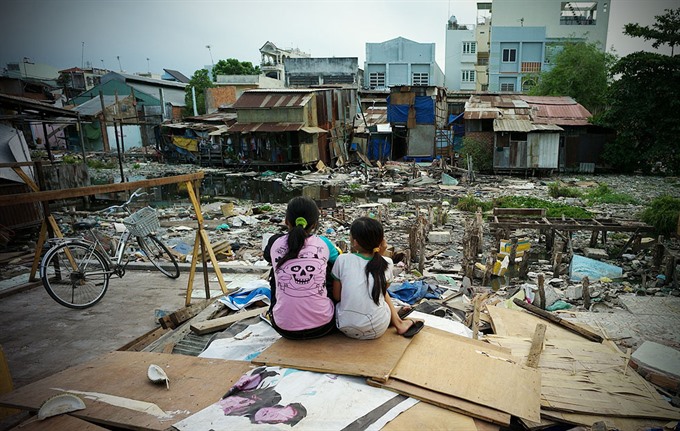 Society
Society

Lack of funds has been blamed for the slow progress of plans to relocate residents of 20,000 houses in slums along canals and rivers in HCM City, Vietnam News Agency reported.
 |
| Children in a slum in HCM City’s District 4. The city has tried to lure private funds to relocate slum dwellers but investors pulled the plug after seeing little in return. — VNS Photo Việt Thanh |
HCM CITY — Lack of funds has been blamed for the slow progress of plans to relocate residents of 20,000 houses in slums along canals and rivers in HCM City, Vietnam News Agency reported.
According to the city’s planning and investment department, relocating those families will require about VNĐ30.8 trillion (US$1.37 billion), while the current budget is only VNĐ2.1 trillion ($93 million).
The city has tried to lure private funds to the project but some interested investors pulled the plug after seeing little in return.
Districts still face many difficulties in defining boundaries, land recovery, resettlement lands, compensation and site clearance. In particular, the amount of compensation allocated for the projects is insufficient for people to build their own housing or buy a house.
A recent Department of Construction report also shows many difficulties in implementing the programme, such as cumbersome administrative procedures.
Therefore the city’s slum relocation programme will likely not meet its 2020 deadline for completion, the department said. So far, only 502 houses have been cleared.
Slums have existed along the canals for more than half a century, mainly in districts 4, 7, 8 and Bình Thạnh. The houses are seriously degraded and often lack toilets. Most of their residents lack steady jobs.
Lê Quỳnh Đài, vice chairman of District 8 People’s Committee, said the progress of relocation was slow and lacked of investors. By June 2018, the district may announce plans for compensation, he added.
Staying put
Most slum inhabitants would like to remain in the area where they live, adding to the obstacles since the compensation for which they are eligible is low and inadequate to pay for housing in the vicinity.
Architecture Phạm Tứ, deputy chairman of the Việt Nam Association of Architects, said that based on the experience of countries around the world, such urban development is inevitable, but vacating entire large areas is not a suitable option.
Under current economic conditions, to make the plan feasible, the city should divide land plots for sale to those who are able to build their own houses, Tứ told Tuổi Trẻ (Youth) newspaper. This will change the land value in the canal areas, especially those in favourable locations, he said.
It will also be less expensive and will not disrupt the habitat of generations of families that have relied on rivers and canals for their living, Tứ added.
According to architect Phạm Anh Tuấn, land adjustment is an important tool to address the challenges of renovating and improving homes along rivers and canals. Instead of moving to other places, residents will have their own land to build new houses. Although the plots will be smaller than their old ones, the value and environment of the area will improve, Tuấn said.
A number of vacant plots can be sold to obtain funds for building public infrastructure or low-income housing, he said. — VNS